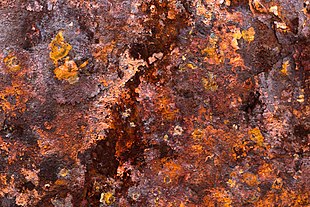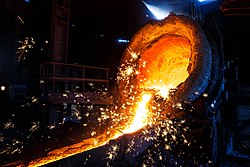Rust: Difference between revisions
m Reverted edits by 99.45.17.225 (talk) to last revision by ClueBot NG (HG) |
Tag: possible vandalism |
||
| Line 7: | Line 7: | ||
Rusting is the common term for [[corrosion]] of iron and its alloys, such as [[steel]]. Many other metals undergo equivalent corrosion, but the resulting oxides are not commonly called rust. |
Rusting is the common term for [[corrosion]] of iron and its alloys, such as [[steel]]. Many other metals undergo equivalent corrosion, but the resulting oxides are not commonly called rust. |
||
who looks at this anyways? |
|||
==Chemical reactions== |
|||
[[Image:RustyChainEdit1.jpg|thumb|right|Heavy rust on the links of a chain near the Golden Gate bridge in San Francisco; it was continuously exposed to moisture and salt-laden spray, causing surface breakdown, cracking, and flaking of the metal.]] |
|||
===Oxidation of iron metal=== |
|||
When impure(cast) iron is in contact with water, oxygen, or other strong oxidants and/or acids, it rusts. If salt is present as, for example, in salt water, it tends to rust more quickly, as a result of the [[Electrochemistry|electro-chemical]] reactions. Iron metal is relatively unaffected by pure water or by dry oxygen. As with other metals, like aluminium, a tightly adhering oxide coating, a [[passivation layer]], protects the bulk iron from further oxidation. Thus, the conversion of the passivating iron oxide layer to rust results from the combined action of two agents, usually oxygen and water. Other degrading solutions are [[sulfur dioxide]] in water and [[carbon dioxide]] in water. Under these corrosive conditions, iron hydroxide species are formed. Unlike iron oxides, the hydroxides do not adhere to the bulk metal. As they form and flake off from the surface, fresh iron is exposed, and the corrosion process continues until either all of the iron is consumed or all of the oxygen, water, carbon dioxide, or sulfur dioxide in the system are removed or consumed.<ref>Holleman, A. F.; Wiberg, E. "Inorganic Chemistry" Academic Press: San Diego, 2001. ISBN 0-12-352651-5.</ref> |
|||
===Associated reactions=== |
|||
[[Image:Rust screw.jpg|thumb|right|A rusted (and dirt-encrusted) bolt; note the surface pitting and gradual shape-deformation, caused by severe oxidation]] |
|||
[[Image:Rust from bathtub in Kyiv.jpg|thumb|Rust in pipes can result in brown and black water.]] |
|||
The rusting of iron is an electrochemical process that begins with the transfer of [[electrons]] from iron to oxygen.<ref>{{cite doi|10.1002/14356007.b01_08}}</ref> <!--Original: <ref>Hubert Gräfen, Elmar-Manfred Horn, Hartmut Schlecker, Helmut Schindler "Corrosion" Ullmann's Encyclopedia of Industrial Chemistry, Wiley-VCH: Weinheim, 2002. DOI: 10.1002/14356007.b01_08</ref> --> The rate of corrosion is affected by water and accelerated by [[electrolyte]]s, as illustrated by the effects of road salt on the corrosion of automobiles. The key reaction is the reduction of oxygen: |
|||
:O<sub>2</sub> + 4 e<sup>-</sup> + 2 H<sub>2</sub>O → 4 OH<sup>-</sup> |
|||
Because it forms [[hydroxide]] [[ions]], this process is strongly affected by the presence of acid. Indeed, the corrosion of most metals by oxygen is accelerated at low [[pH]]. Providing the electrons for the above reaction is the oxidation of iron that may be described as follows: |
|||
:Fe → Fe<sup>2+</sup> + 2 e<sup>−</sup> |
|||
The following redox reaction also occurs in the presence of water and is crucial to the formation of rust: |
|||
:4 Fe<sup>2+</sup> + O<sub>2</sub> → 4 Fe<sup>3+</sup> + 2 O<sup>2−</sup> |
|||
In addition, the following multistep acid-base reactions affect the course of rust formation: |
|||
: Fe<sup>2+</sup> + 2 H<sub>2</sub>O {{unicode|⇌}} Fe(OH)<sub>2</sub> + 2 H<sup>+</sup> |
|||
: Fe<sup>3+</sup> + 3 H<sub>2</sub>O {{unicode|⇌}} Fe(OH)<sub>3</sub> + 3 H<sup>+</sup> |
|||
as do the following dehydration equilibria: |
|||
:Fe(OH)<sub>2</sub> {{unicode|⇌}} FeO + H<sub>2</sub>O |
|||
:Fe(OH)<sub>3</sub> {{unicode|⇌}} FeO(OH) + H<sub>2</sub>O |
|||
:2 FeO(OH) {{unicode|⇌}} Fe<sub>2</sub>O<sub>3</sub> + H<sub>2</sub>O |
|||
[[Image:PyOx.JPG|thumb|left|Rusted [[pyrite]] cubes]] |
|||
From the above equations, it is also seen that the corrosion products are dictated by the availability of water and oxygen. With limited dissolved oxygen, iron(II)-containing materials are favoured, including [[iron(II) oxide|FeO]] and black [[lodestone]] (Fe<sub>3</sub>O<sub>4</sub>). High oxygen concentrations favour [[ferric]] materials with the nominal formulae Fe(OH)<sub>3-x</sub>O<sub>x/2</sub>. The nature of rust changes with time, reflecting the slow rates of the reactions of solids. |
|||
Furthermore, these complex processes are affected by the presence of other ions, such as [[calcium|Ca<sup>2+</sup>]], both of which serve as an electrolyte, and thus accelerate rust formation, or combine with the [[hydroxides]] and [[oxides]] of iron to precipitate a variety of Ca-Fe-O-OH species. |
|||
What's more, rust indicator can be used for testing the presence of Fe2+. Fe2+ turns the rust indicator from yellow to blue. |
|||
==Prevention== |
==Prevention== |
||
Revision as of 17:45, 29 September 2011

| Steels |
|---|
 |
| Phases |
| Microstructures |
| Classes |
| Other iron-based materials |
Rust is a general term for a series of iron oxides. In colloquial usage, the term is applied to red oxides, formed by the reaction of iron and oxygen in the presence of water or air moisture. There are also other forms of rust, such as the result of the reaction of iron and chlorine in an environment deprived of oxygen, such as rebar used in underwater concrete pillars, which generates green rust. Several forms of rust are distinguishable visually and by spectroscopy, and form under different circumstances.[1] Rust consists of hydrated iron(III) oxides Fe2O3·nH2O and iron(III) oxide-hydroxide (FeO(OH), Fe(OH)3). Given sufficient time, oxygen, and water, any iron mass will eventually convert entirely to rust and disintegrate. Surface rust provides no protection to the underlying iron, unlike the formation of patina on copper surfaces.
Rusting is the common term for corrosion of iron and its alloys, such as steel. Many other metals undergo equivalent corrosion, but the resulting oxides are not commonly called rust.
who looks at this anyways?
Prevention
Rust is permeable to air and water, therefore the interior iron continues to corrode. Rust prevention thus requires coatings that preclude rust formation. Stainless steel forms a passivation layer of chromium(III) oxide. Similar passivation behavior occurs with magnesium, titanium, zinc, zinc oxides, aluminium, polyaniline, and other electroactive conductive polymers.
Galvanization
An important approach to rust prevention entails galvanization, which typically consists of an application, on the object to be protected, of a layer of zinc by either hot-dip galvanizing or electroplating. Zinc is traditionally used because it is cheap, adheres well to steel, and provides a cathodic protection to the steel surface in case of damage of the Zinc layer. In more corrosive environments (such as salt water), cadmium is preferred. Galvanization often fails at seams, holes, and joints where the coating is pierced. In these cases, the coating provides cathodic protection to metal, where it acts as a galvanic anode rusting in preference. More modern coatings add aluminium to the coating as zinc-alume; aluminium will migrate to cover scratches and thus provide protection for longer. These approaches rely on the aluminium and zinc oxides protecting the once-scratched surface rather than oxidizing as a sacrificial anode. In some cases, very aggressive environments or long design life, both zinc and a coating are applied to provide corrosion protection.
Cathodic protection
Cathodic protection is a technique used to inhibit corrosion on buried or immersed structures by supplying an electrical charge that suppresses the electro-chemical reaction. If correctly applied, corrosion can be stopped completely. In its simplest form, it is achieved by attaching a sacrificial anode, thereby making the iron or steel the cathode in the cell formed. The sacrificial anode must be made from something with a more negative electrode potential than the iron or steel, commonly zinc, aluminium, or magnesium.
Coatings and painting

Rust formation can be controlled with coatings, such as paint, that isolate the iron from the environment. Large structures with enclosed box sections, such as ships and modern automobiles, often have a wax-based product (technically a "slushing oil") injected into these sections (see Rustproofing). Such treatments also contain rust inhibitors. Covering steel with concrete can provide some protection to steel by the high pH environment at the steel-concrete interface. However rusting of steel in concrete can still be a problem.
Plating

- Zinc Plating (Galvanized iron/steel): Iron or steel coated with zinc metal layer. Hot-dipped method or zinc-blasting method may be used.
- Tin plating : mild steel sheet coated with a tin layer.
- Chrome plating, wherein a thin layer of chromium is electrolytically applied to the steel, providing both rust protection and a highly polished, bright appearance. Often used on the silver-coloured components of bicycles, motorbikes, and automobiles.
Bluing
Bluing is a technique that can provide limited resistance to rusting for small steel items, such as firearms; for it to be successful, water-displacing oil is rubbed onto the blued steel.
Humidity
Rust can be avoided by controlling the moisture in the atmosphere. An example of this is the use of silica gel.
Inhibitors
Corrosion inhibitors, like gas-phase or volatile inhibitors, can be used to prevent corrosion in closed systems.
Economic impact

Rust is associated with degradation of iron-based tools and structures. As rust has a much higher volume than the originating mass of iron, its build-up can also cause failure by forcing apart adjacent parts — a phenomenon sometimes known as "rust smacking". It was the cause of the collapse of the Mianus river bridge in 1983, when the bearings rusted internally and pushed one corner of the road slab off its support. Rust was also an important factor in the Silver Bridge disaster of 1967 in West Virginia, when a steel suspension bridge collapsed in less than a minute, killing 46 drivers and passengers on the bridge at the time.

Kinzua Bridge in Pennsylvania was blown down by a tornado in 2003 largely because the central base bolts holding the structure to the ground had rusted away, leaving the bridge resting by gravity alone.
Likewise, corrosion of concrete-covered steel and iron can cause the concrete to spall, creating severe structural problems. It is one of the most common failure modes of reinforced concrete bridges.
See also

References
External links
- Corrosion Cost A site dedicated to the study of economic impact of Corrosion
- corrosion case studies Analysis of corrosion
- Corrosion Doctors Rusting article
- Metal Corrosion Rust What is Rust
